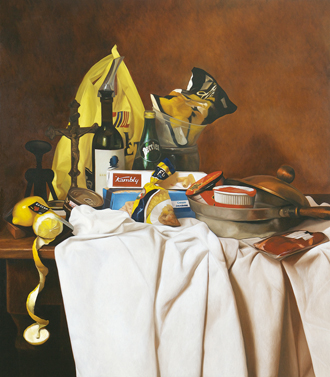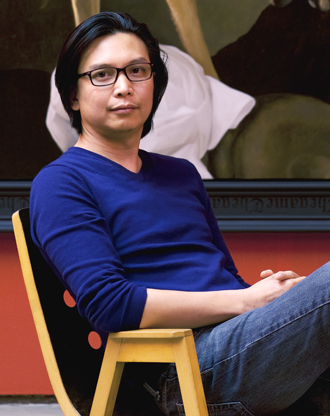Baroque-style art evokes Asia’s present

Thai artist Natee Utarit’s “Still Life with Grocery Food and Opus One” (2013) is part of his first solo show in Korea at Gallery Hyundai. It resembles a typical 17th-century Dutch Golden Age still life but consists of contemporary food, including Korean cup noodles. Provided by the gallery
They will see a group of still-life paintings that resemble those of the Dutch Golden Age, not only in compositions but also in calm, graceful hues. They will also see some paintings that depict dwarfs in Baroque costumes. They will be reminded of the Spanish master Diego Velasquez’s well-known portrait of a dwarf, who was the king’s jester.
But a closer look at these paintings will reveal that they are contemporary artworks tinged with sarcastic humor. The still-life paintings have contemporary food like cans, bags of snacks and even Korean cup noodles. And the dwarves resemble Southeast Asians rather than Europeans, carrying items of contemporary luxury fashion brands. They are part of a solo show of Thai contemporary artist Natee Utarit titled “Optimism is Ridiculous.”
“Southeast Asian artists tend to show strong political or social messages from post-colonialism,” said Lee Won-joon, curator of the show at Gallery Hyundai. “Though Natee Utarit is from Thailand, the only Southeast Asian country which was not colonized by the West, he says he and other Southeast Asians have a kind of fear about Western people and mixed feelings of self-respect and shame in the aftermath of colonization. He expresses it in more delicate and complicated ways than other Southeast Asian artists.”

The artist Natee Utarit
Asked why he uses the style of 17th-century Baroque paintings, Utarit said, “I’d like to test various languages in my conversation through art. An abstract painting is not a proper language to express the chaotic and complicated conditions of contemporary society. The figurative paintings of the Baroque era are full of symbols and allegories. Their styles are realistic and symbolic at the same time, so I apply it.”
The 43-year-old Bangkok-based artist was in Seoul earlier this month for the opening of the exhibition.
He added he could change the style next year, as he has been testing various languages and styles.
Utarit is the first Southeast Asian artist to have a solo show at Gallery Hyundai, one of the biggest galleries in Korea. Reflecting the rising status of Southeast Asian artists in international art fairs and auctions, other major Korean galleries, including Arario Seoul, are also holding Southeast Asian artists’ solo exhibitions now.
The exhibition runs through Sunday. Admission is free. Hours are 10 a.m. to 6 p.m. Tuesday to Sunday. Go to Anguk Station, line No. 3, exit No. 1 and walk for 10 minutes. For details, call (02) 2287-3500, or visit www.galleryhyundai.com.
By Moon So-young [symoon@joongang.co.kr]










with the Korea JoongAng Daily
To write comments, please log in to one of the accounts.
Standards Board Policy (0/250자)